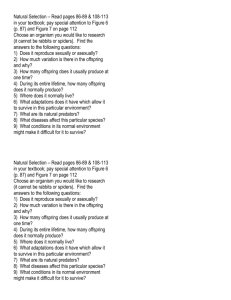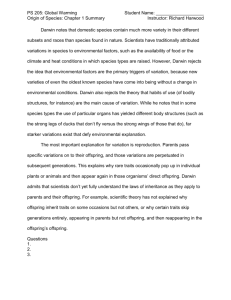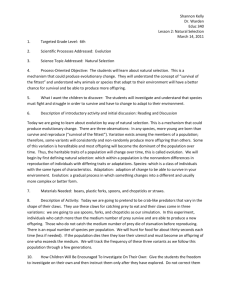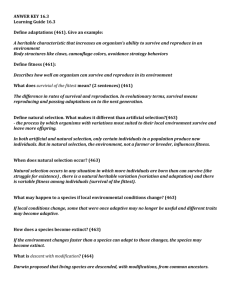evolution Practice quiz
advertisement
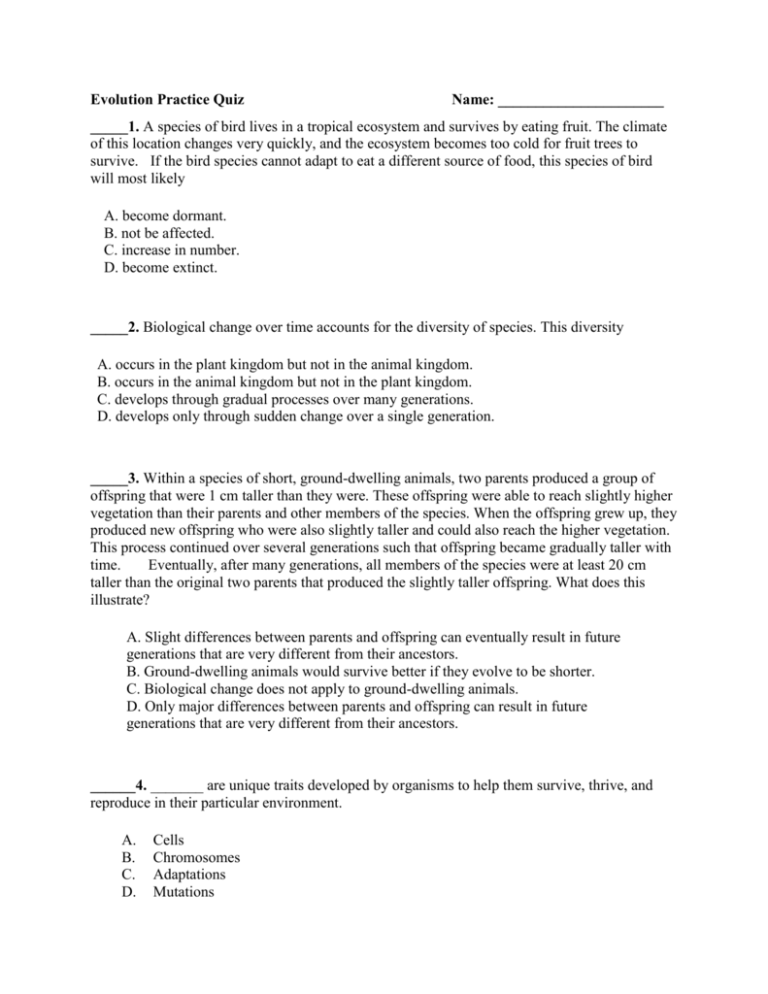
Evolution Practice Quiz Name: ______________________ _____1. A species of bird lives in a tropical ecosystem and survives by eating fruit. The climate of this location changes very quickly, and the ecosystem becomes too cold for fruit trees to survive. If the bird species cannot adapt to eat a different source of food, this species of bird will most likely A. become dormant. B. not be affected. C. increase in number. D. become extinct. _____2. Biological change over time accounts for the diversity of species. This diversity A. occurs in the plant kingdom but not in the animal kingdom. B. occurs in the animal kingdom but not in the plant kingdom. C. develops through gradual processes over many generations. D. develops only through sudden change over a single generation. _____3. Within a species of short, ground-dwelling animals, two parents produced a group of offspring that were 1 cm taller than they were. These offspring were able to reach slightly higher vegetation than their parents and other members of the species. When the offspring grew up, they produced new offspring who were also slightly taller and could also reach the higher vegetation. This process continued over several generations such that offspring became gradually taller with time. Eventually, after many generations, all members of the species were at least 20 cm taller than the original two parents that produced the slightly taller offspring. What does this illustrate? A. Slight differences between parents and offspring can eventually result in future generations that are very different from their ancestors. B. Ground-dwelling animals would survive better if they evolve to be shorter. C. Biological change does not apply to ground-dwelling animals. D. Only major differences between parents and offspring can result in future generations that are very different from their ancestors. ______4. _______ are unique traits developed by organisms to help them survive, thrive, and reproduce in their particular environment. A. B. C. D. Cells Chromosomes Adaptations Mutations _______5. Some organisms have favorable traits that are well-suited to the environment at hand. Organisms with this advantage are more likely to thrive, reproduce, and pass their traits to future generations than organisms without favorable traits. This process is known as A. artificial selection. B. genetic engineering. C. natural selection. D. selective breeding. _______6. Small differences between parents and offspring accumulate over time. This process A. results in many different types of organisms with different characteristics from their ancestors. B. prevents parents from being able to care for their offspring. C. makes it impossible for species to adapt to changes in their environment. D. results in only one type of organism that has the exact same characteristics as its ancestors ______7. A deer is born with the ability to smell predators better than the other deer in its population. As a result, this deer has several seconds of warning every time wolves or other predators attack. This trait may be selected by natural selection because it increases the deer's _______. A. ability to select mates B. ability to survive C. ability to find food D. sense of safety _______8. Which of the following is an example of natural selection? A. Rabbits with a mutation for longer, thicker fur survive an unusually cold winter, while many normal rabbits do not survive. B. To produce a more desirable fruit, a farmer crosses a tree that produces sweet oranges with a tree that produces large oranges. C. Pesticides are sprayed in a field, resulting in an increase in crop growth and a decrease in insect population. D. Cricket Frogs prefer to sleep during the day, while Red-eyed Tree Frogs prefer to sleep during the night. ______9. Over time, the climate of a region becomes cooler. How will this most likely affect the species living in that region? A. Some species that already have or that develop cold-weather adaptations through natural selection will survive, while species without cold-weather adaptations may go extinct. B. All of the current species living in the area will become extinct, and new species better adapted to the climate will form and populate the region. C. All of the current species living in the region will migrate to warmer areas, while species adapted to cold-weather climates will migrate into the region. D. Most of the current species living in the area will develop beneficial mutations, which will lead to adaptations that help them survive in the new climate. _______10. If the environment changes quickly and no individual members of a species are able to survive in the new environment, then the species will A. B. C. D. become extinct. begin mating with other species. turn into a different species. not be affected. _____11. Which of the following is true about natural selection? A. Natural selection usually causes a species to change gradually. B. Natural selection usually causes a species to change suddenly. C. Natural selection does not cause a species to change. D. Natural selection is the only cause of changes in a species. ______12. Evolution is the process by which populations accumulate inherited changes over time. Which of the following mechanisms drives evolution? A. B. C. D. plate tectonics nitrogen fixation fossilization natural selection Answers 1. D 2. C 3. A 4. C 5. C 6. A 7. B 8. A 9. A 10. A 11. A 12. D
